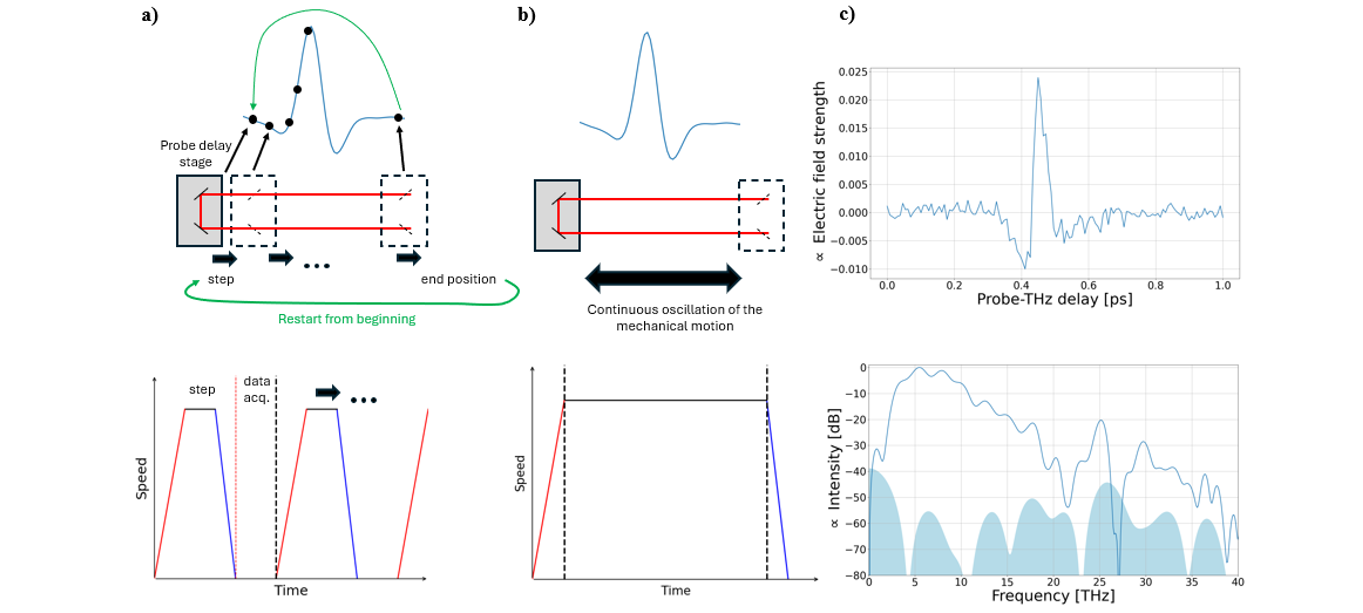| PREVIOUS PRESENTATION | BACK TO PROGRAM OVERVIEW | NEXT PRESENTATION |
High-speed Continuous Waveform Acquisition in Terahertz Air Photonics Platform
Olivér Nagy, Alexander Holm Ohrt, E. J. R. Kelleher, Peter Uhd Jepsen, and Binbin Zhou
Department of Electrical and Photonics Engineering, Technical University of Denmark, DK-2800 Kongens Lyngby, Denmark
The terahertz (THz) air photonics platform enables ultra-broadband THz wave generation and detection, offering significant advantages for spectroscopic studies across various material systems. However, the relatively low operational repetition rate (typically 1 kHz) and the signal processing requirements of the standard air-biased coherent detection (ABCD) [1] technique result in a relatively long waveform acquisition time. This abstract presents our recent advancements in high-speed waveform acquisition for this ultra-broadband THz platform. By utilizing an analog-to-digital (A/D) converter combined with continuous delay line scanning, we demonstrate sub-second ultra-broadband waveform acquisition.

Figure 1: (a) Stage is controlled step-by-step, during THz waveform acquisition (top) and ideal stage speed characteristics (bottom), where the red and blue lines mark the acceleration and deceleration periods, respectively. (b) Digitizing the integrated avalanche photodiode (APD) output and utilizing a balanced terahertz field induced second harmonic (TFISH) signal allows a continuously moving stage to be synchronized with an A/D converter (top), total time cut down by n-1 times the sum of a single acceleration and deceleration period and the time for data acquisition (bottom) (c) THz waveform (and intensity spectrum) acquired within ~0.5 seconds.
Fig. 1a illustrates the procedure for acquiring a series of data points on a THz waveform. A stage controlling the delay between the optical probe delay and the THz signal is configured in a step-acquire mode, where between two steps, a set of incoming signal pulses is either averaged or lowpass-filtered together. The bias modulation scheme of conventional ABCD detection requires two consecutive pulses for a data point extracted from a differential signal. In this scenario, the total acquisition speed depends on the time required for the stage to move between two positions and the time constant for the acquisition. Having a reliable laser source, the former can be reduced significantly. However, the fastest achievable speed will always be fundamentally limited by the mechanical speed and precision of the translation stage. We propose a new approach (Fig. 1b) in which we simplify the detection pipeline, replacing the lock-in amplifier with a low-cost, off-the-shelf (A/D) converter and reconfigure the ABCD with polarization-resolved detection to acquire the differential signal from a single probe pulse (balanced ABCD detection) [2]. Detection of the THz field (t) with a single probe pulse instead of two consecutive pulses is vital for fast acquisition with a continuously scanning translation stage. Careful synchronization between the sampling rate of the A/D converter then enables sub-second acquisition of a full THz waveform (Fig. 1c).
References
[1] N. Karpowicz, J. M. Dai, X. F. Lu, Y. Q. Chen, M. Yamaguchi, H. W. Zhao, X. C. Zhang, L. L. Zhang, C. L. Zhang, M. Price-Gallagher, C. Fletcher, O. Mamer, A. Lesimple, and K. Johnson, “Coherent heterodyne time-domain spectrometry covering the entire “terahertz gap”,” Appl. Phys. Lett. 92, 011131 (2008)
[2] A. H. Orth, O. Nagy, R. Löscher, C. L. Saraceno, B. Zhou, and P. Uhd Jepsen, “Balanced air-biased detection of terahertz waveforms,” in submission (2024)
